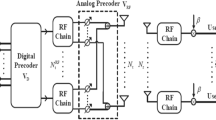Abstract
A beamforming algorithm is introduced based on the general objective function that approximates the bit error rate for the wireless systems with binary phase shift keying and quadrature phase shift keying modulation schemes. The proposed minimum approximate bit error rate (ABER) beamforming approach does not rely on the Gaussian assumption of the channel noise. Therefore, this approach is also applicable when the channel noise is non-Gaussian. The simulation results show that the proposed minimum ABER solution improves the standard minimum mean squares error beamforming solution, in terms of a smaller achievable system’s bit error rate.
Similar content being viewed by others
References
J. H. Winters, J. Salz, R. D. Gitlin. The Impact of Antenna Diversity on the Capacity of Wireless Communication Systems. IEEE Transactions on Communications, vol. 42, no. 2–4, pp. 1740–1751, 1994.
J. Litva, T. K. Y. Lo. Digital Beamforming in Wireless Communications, Artech House, Norwood, MA, USA, 1996.
R. Kohno. Spatial and Temporal Communication Theory Using Adaptive Antenna Array. IEEE Personal Communications, vol. 5, no. 1, pp. 28–35, 1998.
J. H. Winters. Smart Antennas for Wireless Systems. IEEE Personal Communications, vol. 5, no. 1, pp. 23–27, 1998.
P. Vandenameele, L. Van Der Perre, M. Engels. Space Division Multiple Access for Wireless Local Area Networks, Kluwer Academic Publishers, Boston, USA, 2001.
J. S. Blogh, L. Hanzo, Third Generation Systems and Intelligent Wireless Networking — Smart Antenna and Adaptive Modulation, John Wiley and Sons, Chichester, UK, 2002.
A. Paulraj, R. Nabar, D. Gore. Introduction to Space-time Wireless Communications, Cambridge University Press, Cambridge, UK, 2003.
A. J. Paulraj, D. A. Gore, R. U. Nabar, H. Bölcskei. An Overview of MIMO Communications — A Key to Gigabit Wireless. Proceedings of the IEEE, vol. 92, no. 2, pp. 198–218, 2004.
S. Haykin, Adaptive Filter Theory, 3rd edition, Upper Saddle River, Prentice-Hall, NJ, USA, 1996.
S. Chen, S. Tan, L. Xu, L. Hanzo. Adaptive Minimum Error-rate Filtering Design: A Review. Signal Processing, vol. 88, no. 7, pp. 1671–1697, 2008.
C. C. Yeh, J. R. Barry. Adaptive Minimum Bit-error Rate Equalization for Binary Signaling. IEEE Transations on Communications, vol. 48, no. 7, pp. 1226–1235, 2000.
B. Mulgrew, S. Chen. Adaptive Minimum-BER Decision Feedback Equalisers for Binary Signalling. Signal Processing, vol. 81, no. 7, pp. 1479–1489, 2001.
S. Chen, N. N. Ahmad, L. Hanzo. Adaptive Minimum Bit Error Rate Beamforming. IEEE Transactions on Wireless Communications, vol. 4, no. 2, pp. 341–348, 2005.
S. Chen, L. Hanzo, N. N. Ahmad, A. Wolfgang. Adaptive Minimum Bit Error Rate Beamforming Assisted Receiver for QPSK Wireless Communication. Digital Signal Processing, vol. 15, no. 6, pp. 545–567, 2005.
W. M. Brown, R. B. Crane. Conjugate Linear Filtering. IEEE Transactions on Information Theory, vol. 15, no. 4, pp. 462–465, 1969.
B. Picinbono, P. Chevalier. Widely Linear Estimation with Complex Data. IEEE Transactions on Signal Processing, vol. 43, no. 8, pp. 2030–2033, 1995.
P. J. Schreier, L. L. Scharf. Second-order Analysis of Improper Complex Random Vectors and Processes. IEEE Transactions on Signal Processing, vol. 51, no. 3, pp. 714–725, 2003.
Author information
Authors and Affiliations
Corresponding author
Additional information
Xia Hong received her B. Sc. and M. Sc. degrees at National University of Defence Technology, PRC, in 1984 and 1987, respectively, and Ph.D. degree at University of Sheffield, UK, in 1998, all in automatic control. She worked as a research assistant in Beijing Institute of Systems Engineering, PRC, from 1987–1993. She worked as a research fellow in the Department of Electronics and Computer Science at the University of Southampton from 1997–2001. She is currently a lecturer at the School of Systems Engineering, the University of Reading. She was awarded a Donald Julius Groen Prize by IMechE in 1999. She has published over 90 research papers, and coauthored a research book.
Her research interests include nonlinear systems identification, data modelling, estimation and intelligent control, neural networks, pattern recognition, learning theory and their applications.
Sheng Chen received his Ph.D. degree in control engineering from the City University, London, UK, in 1986. He was awarded the Doctor of Sciences (DSc) degree by the University of Southampton, Southampton, UK, in 2005.He joined the School of Electronics and Computer Science, the University of Southampton, UK, in 1999. He previously held research and academic appointments at the University of Sheffield, the University of Edinburgh, and the University of Portsmouth, all in UK. He has published over 300 research papers. In the database of the world’s most highly cited researchers, compiled by Institute for Scientific Information (ISI) of the USA, he is on the list of the highly cited researchers in the engineering category.
His research interests include wireless communications, machine learning and neural networks, finite-precision digital controller design, and evolutionary computation methods.
Rights and permissions
About this article
Cite this article
Hong, X., Chen, S. A minimum approximate-BER beamforming approach for PSK modulated wireless systems. Int. J. Autom. Comput. 5, 284–289 (2008). https://doi.org/10.1007/s11633-008-0284-8
Received:
Revised:
Published:
Issue Date:
DOI: https://doi.org/10.1007/s11633-008-0284-8




